Resident Crews of Salyut 7
![]()
Salyut 7 |
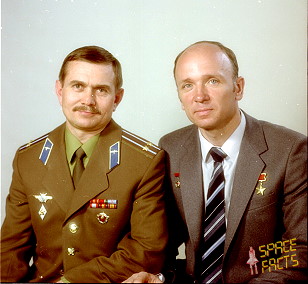 |
|
alternative crew photo |
alternative crew photo |
alternative crew photo |
alternative crew photo |
alternative crew photo |
alternative crew photo |
![]()
Crew, launch- and landing data
| No. | Nation | Surname | Given names | Position | Spacecraft (launch) |
Launch date |
Launch time |
Spacecraft (landing) |
Landing date |
Landing time |
Mission duration |
Orbits |
| 1 | Berezovoy | Anatoli Nikolayevich | Commander | Soyuz T-5 | 13.05.1982 | 09:58:04.059 UTC | Soyuz T-7 | 10.12.1982 | 19:02:36 UTC | 211d 09h 04m 33s | 3344 | |
| 2 | Lebedev | Valentin Vitaliyevich | Flight Engineer | Soyuz T-5 | 13.05.1982 | 09:58:04.059 UTC | Soyuz T-7 | 10.12.1982 | 19:02:36 UTC | 211d 09h 04m 33s | 3344 |
Backup Crew
| No. | Nation | Surname | Given names | Position |
| 1 | Titov | Vladimir Georgiyevich | Commander | |
| 2 | Strekalov | Gennadi Mikhailovich | Flight Engineer |
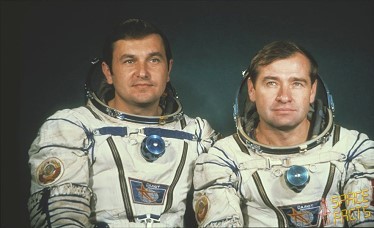 |
alternative crew photo |
Expedition Report
|
Launch from the Baikonur Cosmodrome and
landing with Soyuz
T-7 capsule 70 km northeast of Arkalyk. Following a one-day solo flight Soyuz T-5 docked with the new space station Salyut 7 on May 14, 1982 and became the first resident crew. There was the ejection of a small radioamateur satellite. The Soviets called this the first launch of a communications satellite from a manned space vehicle. Progress 13 was docked to the station from May 25, 1982 - June o4, 1982. During the docking there was a violation of Progress docking procedure. The hatch from the work compartment to the intermediate compartment was to be closed when a Progress docked, but Valentin Lebedev and Anatoli Berezovoy wished to watch the approach through an aft-facing porthole in the intermediate compartment. They therefore 'clamped the endpoints of the hatch, thus simulating its closure for the TsUP's benefit.' They forgot to remove the clamps after Progress 13 docked, giving the TsUP an indication that the hatch remained closed even though the 1st resident crew moved back and forth between Progress 13 and Salyut 7. The TsUP gently called them out for this violation of procedure. On May 25, 1982 the crew reoriented Salyut 7 so the aft end of the Progress pointed toward Earth. This placed the station in gravity-gradient stabilization. Valentin Lebedev remarked in his diary that the attitude control jets were “very noisy”, and that they sounded like “hitting a barrel with a sledgehammer”. Of Salyut 7 during the unpacking of Progress 13, Valentin Lebedev said, “It looks like we’re getting ready to move or have just moved to a new apartment.” The following day the resident crew closed the hatch from the work compartment into the intermediate compartment so the TsUP could pump fuel from Progress 13 to Salyut 7. The crew monitored the operation but played little active role in it. May 29, 1982 was spent organizing the supplies delivered. At the same time, according to Valentin Lebedev, “we filled the resupply ship with what we don’t need and tied them down with ropes. When I enter the resupply ship, it jingles with a metallic sound, so when we separate it will sound like a brass band.” Progress 13 pumped 300 liters of water aboard on May 31, 1982. On June 02, 1982 Progress 13 lowered the station’s orbit to 300 km to receive Soyuz T-6. June 12, 1982 was bath day on Salyut 7, the day the crew was permitted its first monthly shower. Showering was a complicated process so much so that the showers, which were expected to be completed by noon, lasted until after 06 p.m. On June 15, 1982 Valentin Lebedev reported that a brown residue had been deposited between the panes of Salyut 7's UV-transparent portholes. The residue was apparently produced when UV radiation struck the rubber gasket surrounding the panes. Soyuz T-6 was docked to the station from June 25, 1982 - July 02, 1982. During the stay of the visiting expedition, the first resident crew gave visiting Frenchman Jean-Loup Chrétien 'the honor' of ejecting a satellite - Salyut 7's weekly bag of waste - from the small trash airlock. In his diary, Valentin Lebedev quoted Jean-Loup Chrétien as saying Salyut 7 'is simple, doesn't look impressive, but is reliable.' Progress 14 docked with Salyut 7 on July 12, 1982 at 11:41:00 UTC, undocked on August 10, 1982 at 22:11:00 UTC and was destroyed in reentry on August 13, 1982 at 01:29:00 UTC. An EVA by both cosmonauts was performed on July 30, 1982 (2h 33m). Tasks of this EVA were installing a movie camera and a floodlight, replacing samples on the Etalon space exposure experiment and working with the Istok panel, which tested the ability to turn bolts using a special wrench, among others. Medical experiments to find reasons of space sickness were done. Valentin Lebedev first installed a movie camera and a floodlight. Then he replaced samples on the Etalon space exposure experiment, a checkerboard of different materials. He deployed and attached himself to the Yakor foot restraint platform. Once there, he spent considerable time looking at the Earth and inspecting the station. Valentin Lebedev was impressed by how still and silent the station's exterior seemed, given its complex and noisy interior mechanisms. He noted that the green insulation on Salyut 7 had already faded and become grayish, but was otherwise undamaged. He also noted two folded Yakor foot restraints and a cable winch near the base of one of the solar arrays. Part of the purpose of his EVA was to perform assembly and disassembly tasks to allow him to judge the feasibility of the next crew using these to put in place solar array extensions. Then the first resident crew replaced the micrometeoroid, Medusa biopolymer, and Elast thermo-insulation samples panels. Valentin Lebedev worked with the Istok panel, which tested his ability to turn bolts using a special wrench. When the station moved into sunlight, Valentin Lebedev could feel through his gloves that the EVA handrails became hot. The cosmonauts installed additional experiments before returning to the transfer compartment. After the EVA they spent a day storing their space suits. Valentin Lebedev found a 20-mm dent in his helmet, with a small split in the metal, possibly produced by striking it on apparatus in the transfer compartment. 'Thank God the helmet is built with double layers of metal,' he wrote in his diary. From August 20, 1982 - August, 27, 1982 the Soyuz T-7 visiting expedition was aboard the station. This included Svetlana Savitskaya, the first woman to visit space in 20 years. She was given the orbital module of Soyuz T-7 for privacy. The Soyuz T-7 crew delivered experiments and mail from home to the first resident crew. On August 21, 1982 the five cosmonauts traded seat liners between the Soyuz-T's. The Soyuz T-7 crew undocked in SoyuzT-5, leaving the newer Soyuz T-7 spacecraft as a lifeboat for the long-duration crew. On August 29, 1982 Soyuz T-7 was repositioned by rotating Salyut 7, freeing the aft port for Progress 15. On September 07, 1982 the cosmonauts practiced procedures which would come into play in the event of a depressurization of the station. The cosmonauts used a pressure measurement device called Diusa to calculate the time until the station's pressure dropped to 500 mm/Hg. This would tell them how long they had to deactivate the station, gather experiment results and records, put on spacesuits, and enter their Soyuz-T. Medical experiments to find reasons of space sickness were performed. The Progress 15 resupply craft remained docked to the station from September 20, 1982 - October 14, 1982. It was followed by Progress 16 from November 02, 1982 - December 13, 1982. Progress 16 delivered the Iskra 3 satellite. It was deployed from the trash airlock on November 18, 1982. The crew completed their work program and returned to earth aboard Soyuz T-7 on December 10, 1982. The Soyuz spacecraft is composed of three elements attached end-to-end - the Orbital Module, the Descent Module and the Instrumentation/Propulsion Module. The crew occupied the central element, the Descent Module. The other two modules are jettisoned prior to re-entry. They burn up in the atmosphere, so only the Descent Module returned to Earth. Having shed two-thirds of its mass, the Soyuz reached Entry Interface - a point 400,000 feet (121.9 kilometers) above the Earth, where friction due to the thickening atmosphere began to heat its outer surfaces. With only 23 minutes left before it lands on the grassy plains of central Asia, attention in the module turned to slowing its rate of descent. Eight minutes later, the spacecraft was streaking through the sky at a rate of 755 feet (230 meters) per second. Before it touched down, its speed slowed to only 5 feet (1.5 meter) per second, and it lands at an even lower speed than that. Several onboard features ensure that the vehicle and crew land safely and in relative comfort. Four parachutes, deployed 15 minutes before landing, dramatically slowed the vehicle's rate of descent. Two pilot parachutes were the first to be released, and a drogue chute attached to the second one followed immediately after. The drogue, measuring 24 square meters (258 square feet) in area, slowed the rate of descent from 755 feet (230 meters) per second to 262 feet (80 meters) per second. The main parachute was the last to emerge. It is the largest chute, with a surface area of 10,764 square feet (1,000 square meters). Its harnesses shifted the vehicle's attitude to a 30-degree angle relative to the ground, dissipating heat, and then shifted it again to a straight vertical descent prior to landing. The main chute slowed the Soyuz to a descent rate of only 24 feet (7.3 meters) per second, which is still too fast for a comfortable landing. One second before touchdown, two sets of three small engines on the bottom of the vehicle fired, slowing the vehicle to soften the landing. The crew set a new spaceflight record. |
EVA data
| Name | Start | End | Duration | Mission | Airlock | Suit | |
| EVA | Lebedev, Valentin | 30.07.1982, 02:39 UTC | 30.07.1982, 05:12 UTC | 2h 33m | Soyuz T-5 | Salyut 7 | Orlan-D No. 46 |
| SEVA | Berezovoy, Anatoli | 30.07.1982, 02:39 UTC | 30.07.1982, 05:12 UTC | 2h 33m | Soyuz T-5 | Salyut 7 | Orlan-D No. 45 |
Relocations of Manned Spacecrafts
| Spacecraft | from | Undocking | Time UTC | to | Redocking | Time UTC |
| Soyuz T-7 | Salyut 7 - aft port | 29.08.1982 | 14:47 | Salyut 7 - front port | 29.08.1982 | 15:07 |
Photos / Graphics
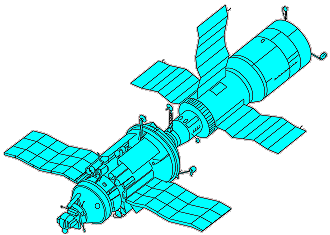 |
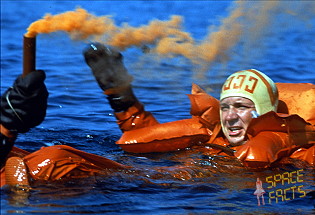 |
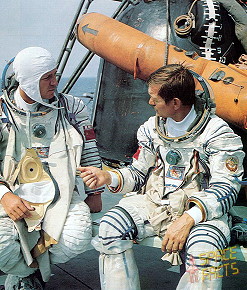 |
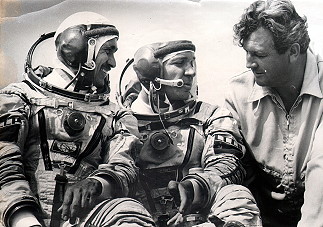 |
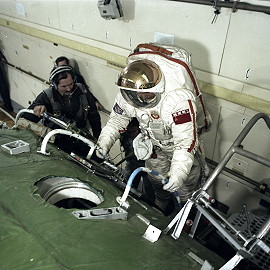 |
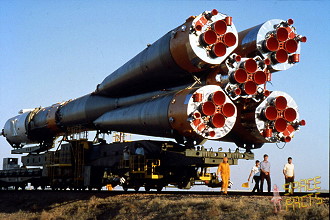 |
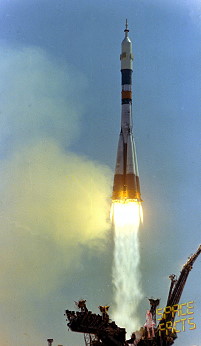 |
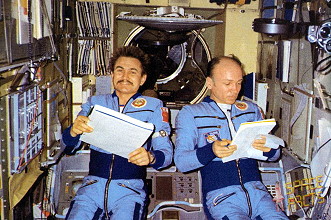 |
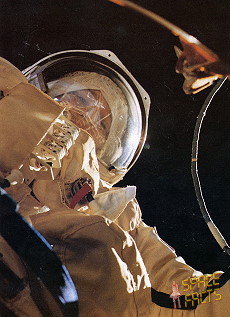 |
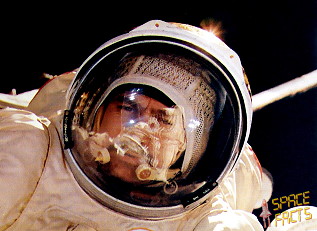 |
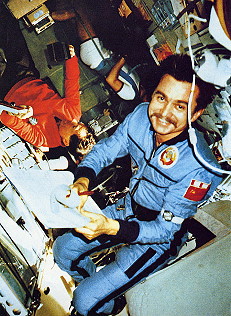 |
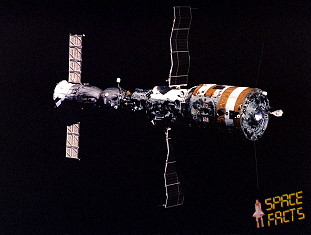 |
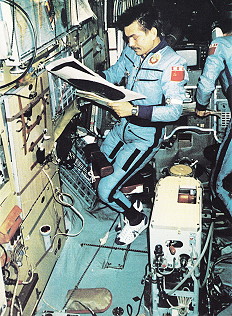 |
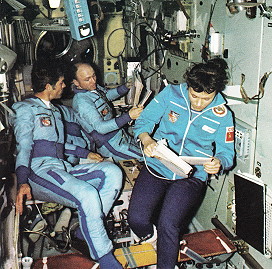 |
 |
 |
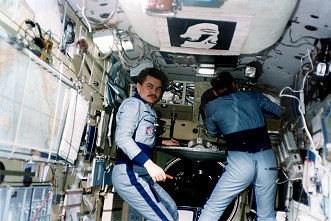 |
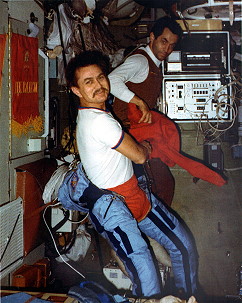 |
 |
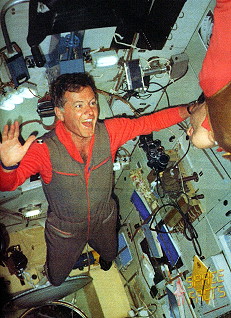 |
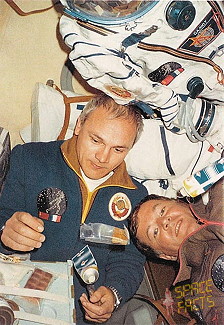 |
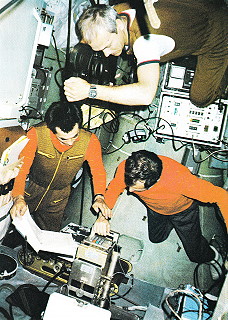 |
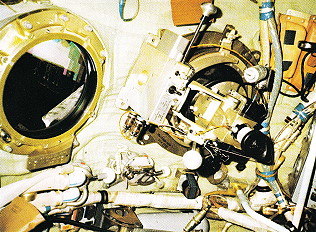 |
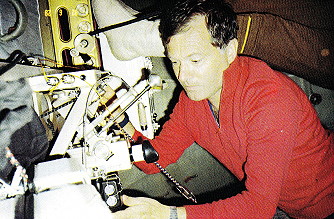 |
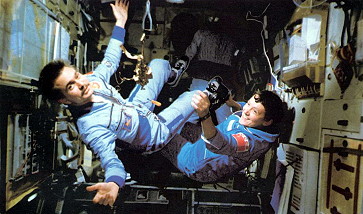 |
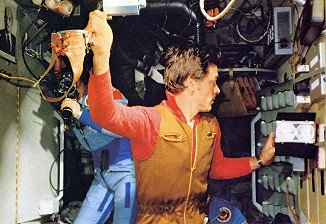 |
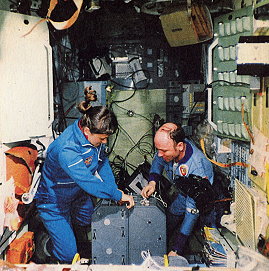 |
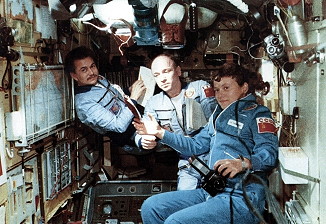 |
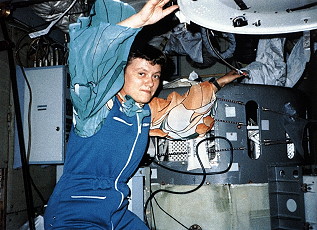 |
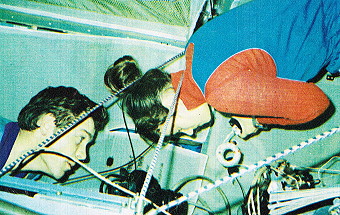 |
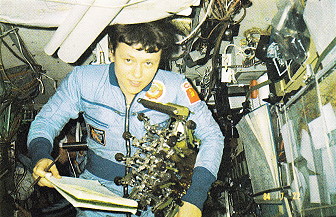 |
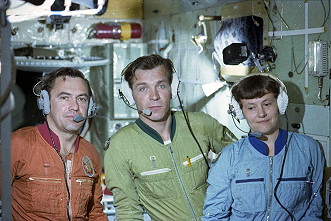 |
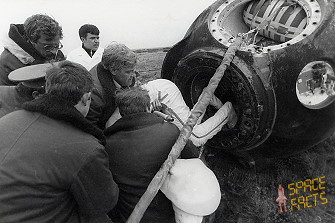 |
| © |  |
Last update on April 30, 2020.  |
 |